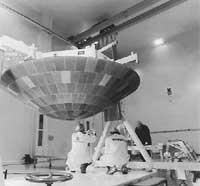Is Saturn alive?
The European Space Agency will send in October next year a probe to the satellite Titan of Saturn. Next to the Huygens probe, NASA's Cassini ship will set off to investigate the largest of Saturn's four satellites.

The atmospheres of Titan and Earth are very similar and not in the entire Solar System. The surface of this large satellite is in turn formed by lakes and continents, in which researchers believe that there may be an interesting mixture of methane and ethane. Some scientists believe that these elements, coming into contact with solar radiation and cosmic rays, can produce the same chemical reactions that occurred when the Earth was formed. Analyzing reactions and confusion, it is believed that dark aspects of Earth's life can be clarified.
When the Huygens probe reaches Titan's atmosphere, it must withstand temperatures close to 2,000°C, but the inside of the apparatus cannot exceed 180 degrees. Therefore, to overcome these temperature changes, the probe will be protected by a silica shield.





